Honey strawberry variety
Honey is a variety of garden strawberries (strawberries) of medium early ripening period. A kind of universal use, non-refurbishing. It was bred by American specialists in 1979, in a place called Honeoye, which is located in New York. In honor of the city in which our heroine was created and named, however, in Russia the name Khonei stuck more, and not Honoai. The "parents" of this strawberry were the Weibrant and Holiday varieties. In Russia, the official distribution of the variety began to be dealt with by employees of the Federal State Budgetary Scientific Institution "North Caucasian Federal Scientific Center for Horticulture, Viticulture, Winemaking", it first appeared in the country back in the 90s. Since 2006, the plants have undergone state tests at variety plots, and in 2013 the variety was added to the state register of breeding achievements of the Russian Federation. Approved for cultivation in three regions of the country: North Caucasian, Central, Central Chernozem.
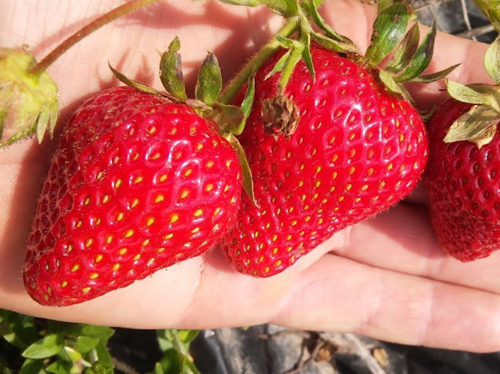
The plant is powerful, erect, abundantly leafy. The leaves are large or medium, concave, pubescent, medium-silvery and medium-wrinkled, dark green, dull. The edges of the leaf plate are serrated, the denticles are obtuse, wide. The middle lobe of the leaf is oval. The petiole of the middle lobe of the leaf plate is longer than the lateral ones. The formation is average, the mustache itself is not long. The flowers are bisexual, strawberries do not need additional pollination. The inflorescence is semi-spreading, consists of many large, untwisted white flowers. The calyx of flowers is medium, pubescent. Peduncles of medium length, thick, located below the level of the leaves or on a par with them.
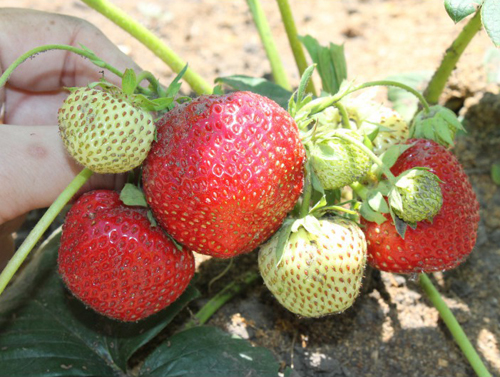
Honey's berries are quite large, have a regular conical shape with a well-defined neck. The skin is dark red with shine. The pulp is red, very dense, juicy, weak aroma, practically absent. Achenes are light yellow, shallowly pressed into the pulp. The berry has a harmonious sweet and sour taste, with incomplete ripening acid prevails. Many gardeners note that bitterness is often present in the taste of this strawberry, it is especially pronounced with mistakes in agricultural technology. In general, the variety has a peculiarity - the best taste appears only when the berries are fully ripe, as indicated by the complete coloring of the fruit in a dark red color. In an unripe berry, the tip has a light color, while the taste of such a specimen leaves much to be desired. The pulp contains: dry matter - 6.2-9.2%, sugar - 4.7-7%, ascorbic acid - 42.7-87.1 mg / 100g, vitamin P - 72.3-127 mg / 100 g, vitamin C - 67.6 mg%.
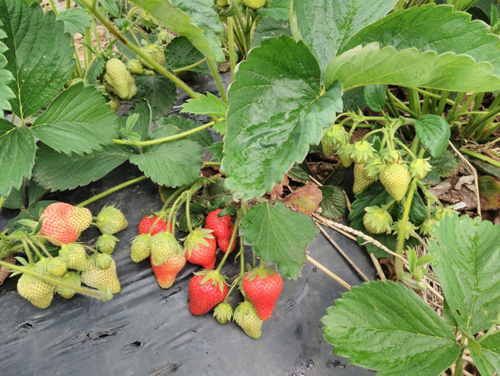
Strawberries for universal use, can be grown both on a personal plot for personal consumption, and on large areas for sale. The berries are dense, therefore they perfectly tolerate transportation, moreover, they are easily separated from the stalk without damage, remain dry and very beautiful. Fresh fruits can be stored for up to 3 days without loss of marketability and taste. The berries are good fresh, but they are best for processing. One nuance should be mentioned. Honey was originally bred to produce a high-yielding variety with berries that could be processed on an industrial scale. Therefore, the taste of our heroine can hardly be called outstanding. In addition, the harvesting of unripe berries is often carried out on large plantations, so they enter the market in a state when they have not yet managed to form a bright taste palette with sufficient sweetness.
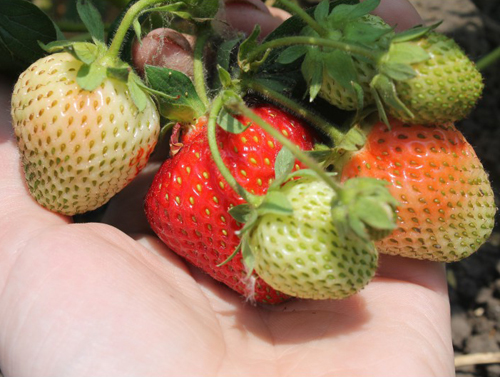
The average weight of strawberries at the first harvest is 20.2 grams, with intensive cultivation, as well as in closed ground - about 30 grams. The weight of individual specimens can reach 45 grams. In subsequent harvests, the weight of the berries gradually decreases, but does not drop below 16 grams. According to the results of the state tests of the variety, the average yield was more than 105 c / ha.According to the originator, yield indicators can reach 12-15 tons per hectare of area. From one plant, it turns out to collect about 400-500 grams of fruit.
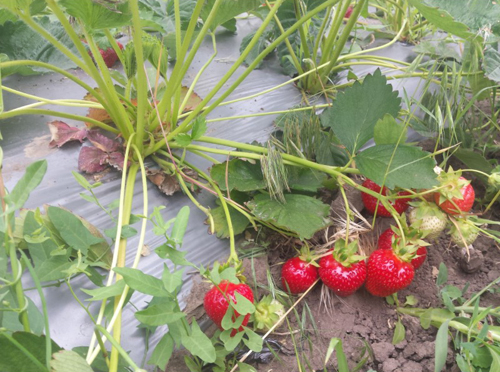
Honey has a fairly short fruiting period, gives the entire crop in about three harvests. The variety is medium early, the beginning of ripening occurs in the second or third decade of May. The berries ripen together, which is very convenient especially for those who grow strawberries for sale. Flowering lasts about fifteen days, moreover, it begins quite early, which is why the variety is not particularly suitable for cultivation in the northern regions. In general, plants have good winter hardiness, but buds and flowers can be very badly damaged during spring frosts. Thus, if you do decide to grow these strawberries in the wrong region, you should take care of a good shelter. In greenhouses and greenhouses, early flowering will not be a problem. Active formation of mustache begins in mid-June, from this moment it is necessary to pay attention to the rationing of the number of mustaches. Remember that they take up a lot of nutrition, and if you want to get more large berries, then they need to be removed in a timely manner.

Strawberries are hardy, practically not damaged by winter thaws. In snowless winters, plants are able to withstand temperatures down to -15 ° C, however, shelter is highly desirable. With a plentiful amount of snow, Khonya feels great even in very cold winters. The variety also has good resistance to drought and heat. However, there are reviews that the berries are often baked in the sun, especially if there are a lot of them and the leaves do not cover them enough from sunlight.
The variety is quite picky about soil fertility, shows the best yield on soils rich in nutrient and mineral composition. This strawberry is perfectly adapted in the Krasnodar Territory and the regions of the North Caucasus, it is in these areas that it is able to show the best results. But in other, less suitable areas for her, it can perfectly take root. However, you will have to try hard to get a lot of delicious berries. Below is a small list of agrotechnical features of growing Honey.
- The originator provides recommendations for the planting pattern: 70-90 × 25-35 cm with one-sided, 70-100 + 30-40 × 25-35 cm with two-sided.
- It is better to plant plants in a sunny place. With a lack of light, the berries will be smaller, and their taste will noticeably deteriorate - sourness and even bitterness will prevail.
- The variety is particularly demanding on the mineral composition of the soil, so you should pay attention, first of all, to fertilizing with microelements. It will be enough to apply fertilizer two or three times. Plants are distinguished by rapid spring development, therefore, it is advisable to carry out not only root, but also foliar feeding. This technique allows the strawberries to get the nutrients they need faster.
- Honey very badly tolerates waterlogging of the soil, but the lack of moisture also affects the plants painfully. The best solution would be to install a drip irrigation system. In general, the taste of berries strongly depends on the optimum level of soil moisture. With a lack of moisture, as well as with its excess, the fruits will be more sour, and sometimes with bitterness.
- The plantation should be rejuvenated every 4-5 years. If this is not done, strawberries will become more vulnerable to disease, and the berries will become noticeably smaller and take on ugly shapes.
The variety is highly resistant to diseases of foliage, and has medium resistance to diseases of the root system. Gardeners noticed that plants are prone to damage by verticillary wilt, in rainy seasons they can be affected by powdery mildew. Our heroine is moderately resistant to pests.
It is worth taking stock. Honey is a great variety with a lot of potential.It is one of the most common in Europe. It is especially in demand among large agricultural complexes that grow strawberries on an industrial scale. However, our heroine has her own characteristics, which are often not liked by ordinary summer residents. This is whimsical care, and exactingness to soil fertility, and early flowering (this can really become a serious problem in some regions). But the main one is the rather peculiar taste of the berries. But nevertheless, it must be said that, with proper agricultural technology and harvesting of fruits at the stage of full maturity, the taste of the variety is very good. It is also worth mentioning that this variety is more intended for obtaining early marketable products, and it fully justifies its purpose. As for the taste, everyone has different preferences, and it is possible to say exactly how tasty Khonei is only after a personal tasting.









I have been growing this strawberry for 5 years - I appreciate it for an early friendly harvest. It grows in an area where the sun is from noon - due to this, it is more humid than in other places. Strawberries turn out to be large, dense, the berry crunches a little, especially the first ones, when they are harvested 2 - 3 days before full ripening. I grow only for food. I lead two beds at a distance of 60 cm. In the aisle I make a shallow ditch, where in the summer I dump organic matter and mowed grass, sprinkling it with earth. For a couple of years, an excellent soil is formed, I root a mustache in it, and remove old bushes. Thus, my beds "crawl" every three years.
This variety of garden strawberries is one of my favorites. The bushes grow large, there are many fruit cones - there are a lot of berries, they ripen for a long time and practically do not shrink. Taste is a separate "song": the berries of this culture should never be picked unripe - they lose a lot in taste and juiciness, but even at the stage of full ripeness they remain dense and can lie in a cool place for several days, ideal for freezing or processing ... I disagree with the previous comment - the longer the Honey grows in one place, the more abundant I get the harvest (the first planting lasted 7 years - the garden had to be moved to the 8th year for "technical reasons"). And I can also say that the bushes tolerate winters well, and in case of freezing, they quickly recover. I am very happy with the variety.